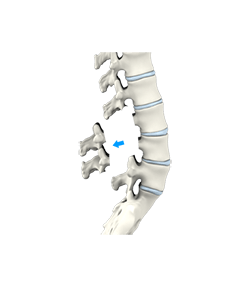Lumbar Laminectomy

What is Lumbar laminectomy?
Lumbar laminectomy is a spinal surgery to relieve excess pressure on the spinal cord or nerves within the spinal canal in the lumbar or lower back region. The pressure may be caused by bony overgrowths, herniated discs, injury, tumors, or narrowing of the spinal canal resulting in painful symptoms affecting a person’s ability to perform normal day to day activities. The purpose of a lumbar laminectomy is to remove the lamina or roof of the vertebra to provide enough space for the spinal cord or nerves to exit the spinal canal without pressure. Lumbar laminectomy is also known as decompression surgery.
Anatomy of the Lumbar Spine
The spine consists of 33 vertebral bones stacked one on top of the other, with cushioning discs present between each vertebra. The lumbar spine in the lower back is composed of 5 vertebrae numbered L1–L5. Towards the front of each vertebra is a cylindrical block of bone called the vertebral body. The spongy vertebral discs are present between the vertebral bodies providing support and enabling movement. Damage or degeneration of the vertebral bodies or discs can lead to nerve compression causing pain, weakness, or numbness.
Indications
Spinal stenosis is one of the major indications for undergoing a lumbar laminectomy. Spinal Stenosis involves the narrowing of the spinal canal due to arthritic changes in the facet joints and intervertebral discs. This causes enlargement of the joint leading to pressure on the spinal nerves. Symptoms of spinal stenosis include back pain or radiating pain into the hips, buttocks or legs, numbness or muscle weakness, and tingling sensations in the back and lower extremities.
Causes of spinal stenosis include:
- Degenerative spinal conditions such as herniated discs.
- Spinal fractures.
- Tumors.
- Infection.
Preparation for Surgery
Preoperative preparation for lumbar laminectomy will involve the following:
- Your doctor will review your medical history and perform a thorough examination.
- Diagnostic tests such as blood work and imaging will be ordered.
- You will need to refrain from medications such as blood thinners, aspirin, or anti-inflammatory drugs for a week or two prior to surgery.
- Avoid alcohol or tobacco at least 24 hours prior to surgery.
- Do not consume any solids or liquids at least 8 hours prior to surgery.
Surgical procedure.
- Lumbar laminectomy is usually performed under general anesthesia. During this procedure:
- You will lie face down on the operating table.
- Your surgeon makes an incision along the midline of the back and carefully retracts the soft tissues and muscles to gain visibility of the spine.
- A part of or the entire lamina is removed to eliminate the pressure on the spinal nerves.
- In addition, any other sources of compression present, such as bone spurs or damaged discs, are removed to relieve nerve compression.
- In some cases, a spinal fusion may also be performed if you have slipped vertebrae or spinal curvature. During spinal fusion, your doctor fuses two or more of your vertebrae together to stabilize the spine.
- At the end of the procedure, your surgeon realigns the soft tissues and the incision is closed with sutures and covered with sterile bandages.
Postoperative care.
In general, postoperative care instructions and recovery involve the following steps:
- You will be transferred to the recovery area for observation where a nurse will monitor your vital signs as you recover.
- You may need to stay 1 to 3 days in the hospital.
- You will most likely be able to get out of bed and walk around on the same day of your surgery.
- Medications are provided as needed to manage pain, swelling, and infection.
- Instructions on diet, bathing, driving, and surgical site care are provided.
- An individualized physical therapy regimen is designed to help strengthen your spine muscles and optimize spine function.
- Avoid strenuous activities, twisting, or lifting heavy weights for at least a month.
- A gradual increase in activities over a period of 4 to 6 weeks is recommended.
- You will be able to resume your normal activities in a couple of months; however, return to sports may take anywhere from 3 to 6 months.
- A periodic follow-up appointment will be scheduled to monitor your progress.
Risks and Complications.
Some of the risks and complications of lumbar laminectomy include:
- Infection.
- Spinal fluid leak.
- Nerve damage.
- Bleeding.
- Blood clots.
- Anesthetic risks.
- Persistence of pain and other symptoms.
